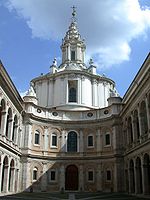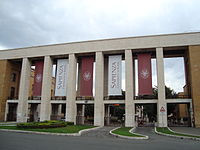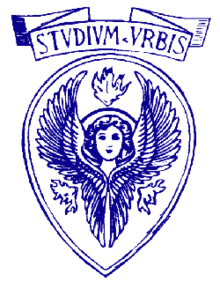- Sapienza University of Rome
-
Coordinates: 41°54′12″N 12°30′57″E / 41.90333°N 12.51583°E
Sapienza
University of Rome
Sapienza – Università di Roma
Latin: Studium Urbis Motto Il futuro è passato qui Motto in English The future is past here or The future has passed here Established 1303 Type State-supported Rector Prof. Luigi Frati Admin. staff 10,144 Students 147,000 Location Rome, Italy Sports teams CUS Roma (http://www.cusroma.org/) Website www.uniroma1.it/ 
The Sapienza University of Rome, officially Sapienza – Università di Roma,[1] formerly known as Università degli studi di Roma "La Sapienza", is a coeducational, autonomous state university in Rome, Italy. It is the largest European university and the oldest of Rome's three state-funded universities; Sapienza was founded in 1303, more than six centuries before Tor Vergata and Roma Tre. In Italian, sapienza means "wisdom" or "knowledge". According to the Academic Ranking of World Universities published by the Institute of Higher Education of Shanghai Jiao Tong University, Sapienza University of Rome ranks among the top 30 European universities. In 2010 QS World University Rankings[2] ranked the university 190th overall in the world.
Contents
History
 Church of Sant'Ivo alla Sapienza, by Borromini, originally a chapel of the Sapienza see.
Church of Sant'Ivo alla Sapienza, by Borromini, originally a chapel of the Sapienza see.
Sapienza University of Rome was founded as La Sapienza in 1303 with the bull In supremae praeminentia dignitatis issued on 20 April 1303 by Pope Boniface VIII, as a Studium for ecclesiastical studies more under his control than the universities of Bologna and Padua.[3]
In 1431 Pope Eugene IV completely reorganized the studium with the bull In supremae, in which he granted masters and students alike the broadest possible privileges and decreed that the university should include the four faculties of Law, Medicine, Philosophy and Theology. He introduced a new tax on wine in order to raise funds for the university; the money was used to buy a palace which later housed the Sant'Ivo alla Sapienza church.
However the University's days of splendour came to an end during the sack of Rome in 1527 when the studium was closed and the professors dispersed; some were killed. Pope Paul III restored the university shortly after his ascension to the pontificate in 1534.
In the 1650s the university became known as Sapienza, meaning wisdom, a title it retains. In 1703 Pope Clement XI purchased some land with his private funds on the Janiculum, where he made a botanical garden, which soon became the most celebrated in Europe through the labours of the Trionfetti brothers.
University students were newly animated during the 19th-century Italian revival. In 1870, La Sapienza stopped being the papal university and became the university of the capital of Italy. In 1935 the new university campus, planned by Marcello Piacentini, was completed. On 27 October 1935 the university became an aggregate of all the institutions of higher learning of university rank in the city of Rome. Since 1935 Sapienza University has been under the control of the Italian Government.
As of the 2007-2008 academic year the Sapienza University of Rome possesses twenty-one faculties and 140,250 students. The Alessandrina University Library (Biblioteca Universitaria Alessandrina), built in 1667 by Pope Alexander VII, is the main library housing 1.5 million volumes; it has some important collections including collezione ciceroniana, Fondo Festa, etc. Sapienza University has many campuses in Rome but its main campus is the Città Universitaria, which covers 439,000 square metres near Termini Station. The university has four satellite campuses outside Rome, in Civitavecchia, Latina, Pomezia and Rieti.
Sapienza Today
Today Sapienza is by far the largest university in Rome, a leading centre of research and academic excellence in all fields of knowledge.[4] In order to cope with the ever-increasing number of applicants, the Rector has approved a new plan to expand the Città Universitaria, reallocate offices and enlarge faculties, as well as create new campuses for hosting local and foreign students, in collaboration with the city of Rome. The university has improved its research programmes in the fields of engineering, natural sciences, biomedical sciences and humanities through the "Sapienza Innovation" programme. Recent cooperation with major British and American universities has resulted in scholarships for Sapienza students through large multicultural exchange programmes, for many faculties.[5]
Admission
In order to cope with the large demand for admission to the university courses, some faculties hold a series of entrance examinations. The "SiOrienta" [3] programme guides students of natural and mathematical sciences as well as the ones belonging the engineering department through the entire admission procedure. The entrance test often decides which candidates will have access to the undergraduate course. For other faculties, the entrance test is only a means through which the administration acknowledges the students' level of preparation. Weak students that haven't passed the test will be enrolled in a number of extra-curriculum preparation courses. Many other faculties don't make use of any entrance test and others use it only as an aptitudinal test.[citation needed]
Organization
Faculties
The university is divided into 11 faculties:
- Faculty of Architecture
- Faculty of Economics
- Faculty of Civil and Industrial Engineering
- Faculty of Information Engineering
- Faculty of Law
- Faculty of Mathematical, Physical and Natural Studies
- Faculty of Medicine and Dentistry
- Faculty of Medicine and Psychology
- Faculty of Pharmacy and Medicine
- Faculty of Philosophy, Arts and Humanities and Oriental Studies
- Faculty of Political Science, Sociology and Communication Science
Research centers & major research groups
There are 5 Atenei federati, 2 Scuole, and over 30 Centri di Ricerca e studio:
- Ateneo Federato della Scienza e della Tecnologia (AST)
- Ateneo Federato delle Scienze delle Politiche Pubbliche e Sanitarie (SPPS)
- Ateneo Federato delle Scienze Umane, delle Arti e dell'Ambiente
- Ateneo Federato delle Scienze Umanistiche, Giuridiche e Economiche
- Ateneo Federato dello Spazio e della Società
- Scuola di Ingegneria Aerospaziale, near San Pietro in Vincoli
- Scuola Speciale per Archivisti Bibliotecari, in Viale Regina Elena
- Center for Research in Neurobiology "Daniel Bovet"
- Centro de La Sapienza per la ricerca sulla formazione e sull'innovazione didattica (CARFID)
- Centro di Ricerca de La Sapienza Scuola del mare
- Centro di Ricerca per la tutela della persona del minore
- Centro di Ricerca de La Sapienza di Economia Internazionale (CIDEI)
- Centro di Ricerca de La Sapienza in Studi europei ed internazionali (EuroSapienza)
- Centro di Ricerca de La Sapienza per le Malattie sociali (CIMS)
- Centro di Ricerca de La Sapienza sul Diritto e l'economia dei mercati (CIDEM)
- Centro di Ricerca de La Sapienza Archivio del Novecento
- Centro di Ricerca de La Sapienza per lo Studio delle Funzioni Mentali (CSFM)
- Centro di Ricerca in Metodologia delle Scienze (CERMS)
- Centro di Ricerca in Psicologia Clinica
- Centro di Ricerca Interdisciplinare Territorio Edilizia Restauro Ambiente (CITERA)
- Centro di Ricerca Museo Laboratorio di Arte Contemporanea (MLAC)
- Centro di Ricerca per il Trasporto e la Logistica (CTL)
- Centro di Ricerca per la Sperimentazione Clinica (CRISC)
- Centro di Ricerca per le Nanotecnologie
- Centro di Ricerca 'Prevenzione, previsione e controllo dei rischi geologici' (CERI)
- Centro di Ricerca Studi per lo Sviluppo (SPES)
- Centro di Ricerca su Roma (CISR)
- Centro Interdipartimentale di scienza e tecnica (CIST)
- Centro Interdisciplinare di Ricerca sulle Disabilità (CIRID)
- Centro Interdisciplinare per il Turismo, il Territorio e l'Ambiente (CITTA)
- Centro Interuniversitario Internazionale di Studi sulle Culture Alimentari Mediterranee (CIISCAM)
- Centro per le applicazioni della televisione e delle tecniche di istruzione a distanza (CATTID)
- Centro Teatro Ateneo (CTA) Centre for Research on the Performing Arts [6][7]
- Interdepartmental Research Center for Models and Information Anaysis in Biomedical Systems (CISB)
- Centro Ricerche Aerospaziali, responsible for the Italian rocket program - Based on San Marco platform at the Broglio Space Centre
- SPES Development Studies – Research centre on Development studies at La Sapienza[8]
People
Law & Social Science
- Carlo Costamagna
- Roberto Forges Davanzati, political science
- Cardinal Mazarin
- Mario Oriani-Ambrosini
- Antonio Salandra
Architecture
- Ernesto Basile
- Bruno Zevi
Sciences
- Lucio Bini and Ugo Cerletti, psychiatrists
- Corrado Böhm, computer scientist
- Daniel Bovet, pharmacologist, Nobel prize winner (1957)
- Benedetto Castelli, mathematician
- Andrea Cesalpino, physician and botanist
- Federigo Enriques, mathematician
- Clelia Giacobini, microbiologist
- Maria Montessori, physician and paedagogist
- Paola S. Timiras, biologist
- Barnaba Tortolini, mathematician
- Vito Volterra, mathematician
Physics
- Via Panisperna boys:
- Enrico Fermi, Nobel prize winner (1938)
- Edoardo Amaldi
- Oscar D'Agostino
- Ettore Majorana
- Bruno Pontecorvo
- Franco Rasetti
- Emilio G. Segrè, Nobel prize winner (1959)
- Giovanni Battista Beccaria
- Marcello Conversi
- Giovanni Ciccotti
- Giovanni Jona-Lasinio
- Francesco Guerra
- Luciano Maiani
- Domenico Pacini
- Giorgio Parisi
- Antonio Signorini
- Nicola Cabibbo, President of the Pontifical Academy of Sciences
Humanities
- Giuseppe Scaraffia, literary critic
- Daria Galateria, writer and translator
- Luigi Ferri, philosopher
- Giovanni Vincenzo Gravina, jurisconsult
- Silvia Berti, historian
- Lazarus Buonamici, renaissance humanist
- Umberto Cassuto, Hebrew language and Bible scholar
- Carlo Innocenzio Maria Frugoni, poet
- Count Angelo de Gubernatis, orientalist
- Predrag Matvejevic, writer and academic
- Santo Mazzarino, leading historian of ancient Rome and ancient Greece
- Giuseppe Tucci, orientalist
- Mario Liverani, orientalist
- Paolo Matthiae, director of the archeological expedition of Ebla
- Marcel Danesi, language scientist
- Antonio Nibby, archaeologist
- Giuliano Amato, law professor and twice Prime Minister of Italy
- Diego Laynez, second general of the Society of Jesus;
- Giulio Mazzarino, politician and cardinal
- Pierluigi Petrobelli, musicologist
- Ugo Spirito, philosopher
- Giuseppe Ungaretti, poet
- Bernardino Varisco, philosopher
- Musine Kokalari, Albanian writer
- Giulio Salvadori, literary critic and poet
Alumni
- Severino Antinori, embryologist
- Sergio Balanzino, ambassador
- Pietro Belluschi, architect
- Bernardo Bertolucci, film director
- Maurizio Cheli, astronaut
- Domenico Comparetti, classic literature scholar
- Gabriele D'Annunzio, poet
- Mario Draghi, governor of the Bank of Italy
- Cristina Ali Farah, writer
- Carlo Fea, archaeologist
- Massimiliano Fuksas, architect
- Romaldo Giurgola, architect
- Umberto Guidoni, astronaut
- Antonio Monda, film director
- Maria Montessori, educator
- Luca di Montezemolo, CEO
- Scott O'Dell, novelist
- Gian Vittorio Rossi, poet and philologist
- Crescenzio Sepe, cardinal
- Abdirashid Ali Shermarke, president and prime minister of Somalia
Points of interest
- Orto Botanico dell'Università di Roma "La Sapienza", a botanical garden
- Sant'Ivo alla Sapienza
- San Pietro in Vincoli: the cloister is part of the Faculty of Engineering
See also
- ESDP-Network
- List of Italian universities
- University of Rome Tor Vergata
- University of Roma Tre
- List of medieval universities
References
- ^ Official Sapienza University of Rome name and logos writing guidelines
- ^ "QS World University Rankings 2010 Results". http://www.topuniversities.com/university-rankings/world-university-rankings/2010/results.
- ^ History
- ^ "QS World University Rankings 2010 Results". http://www.topuniversities.com/university-rankings/world-university-rankings/2010/results.
- ^ www.uniroma1.it
- ^ [1]
- ^ [2]
- ^ SPES Development Studies Research Centre at the University of Rome La Sapienza
External links
- (Italian) University of Rome La Sapienza Website
La Sapienza • Tor Vergata • Roma Tre • "Foro Italico" • LUISS • S. Pio V • Maria SS. Assunta • BiomedicalInstitutional Network of the Universities from the Capitals of Europe (UNICA) Amsterdam (UvA) · Athens · Belgrade · Berlin (FUB) · Berlin (HUB) · Bratislava · Brussels (VUB) · Brussels (ULB) · Bucharest · Budapest · Copenhagen · Dublin (UCD) · Helsinki · Lausanne · Lisboa · Ljubljana · London (UCL) · Madrid (UAM) · Madrid (UCM) · Moscow · Nicosia · Oslo · Paris I · Paris III · Paris VI · Paris-Dauphine · Prague · Riga · Rome-La Sapienza · Rome-Tor Vergata · Rome-Tre · Skopje · Sofia · Stockholm · Tallinn (TU) · Tallinn (TUT) · Tirana · Vienna · Vilnius · Warsaw · Zagreb
Mediterranean Universities Union (UNIMED) Africa Algeria Egypt Libya Morocco Tunisia Europe Albania Cyprus Finland France Greece Italy Bari · Bologna · Camerino · Catania · Messina · Modena · Molise · Naples 2nd · Naples Federico II · Padua · Palermo · Perugia · Perugia Foreigners · Reggio Calabria · Roma Tre · Rome la Sapienza · Rome S. Pio V · Salento · Sassari · Teramo · Turin · UrbinoMalta Montenegro Portugal Slovenia Spain Western Asia Israel Jordan Lebanon Lebanese University · Saint-Esprit de KaslikPalestinian territories Syria Categories:- Sapienza University of Rome
- 1303 establishments
- Educational institutions established in the 14th century
- Universities in Italy
- Universities and colleges in Rome
- Education in Rome
Wikimedia Foundation. 2010.


